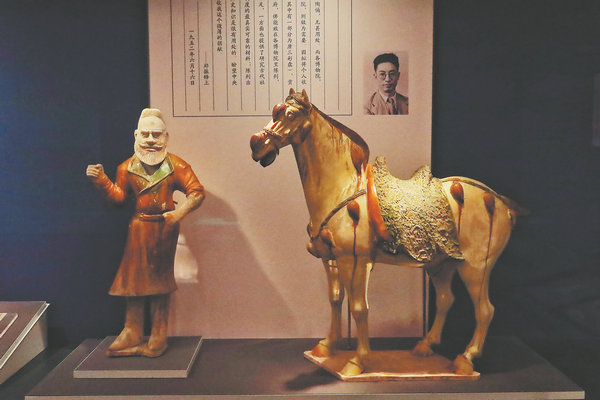
A group of Tang Dynasty tri-colored (sancai) ceramic statues donated by Zheng Zhenduo in the 1950s are displayed at the exhibition. [Photo by JIANG DONG/CHINA DAILY]
Among the 1.95 million cultural relics housed in China's largest museum in terms of collection scale, the Palace Museum in Beijing, also known as the Forbidden City, nearly 35,000 were donated by about 800 individuals since the victory in the Chinese People's War Against Japanese Aggression (1931-45) 80 years ago.
That "small" number of relics might appear trivial, with most of the rest coming from the former royal collection of the Qing Dynasty (1644-1911) due to the museum's status as an imperial palace from 1420 to 1911.
Nevertheless, in the eyes of cultural relic custodians, these donors have made exceptional contributions in the preservation of Chinese civilization, which also designates this "small" group of relics as special treasures.
This month marks the 100th anniversary of the founding of the Palace Museum. In celebration, a yearlong exhibition was launched last week in the museum's Palace of Great Benevolence (Jingren Gong) to honor these generous donations.
About 100 artifacts, which were donated by 100 people in the past decades, are displayed in the Benevolence in Motion: Donated Artifacts in the Palace Museum exhibition.
Calligraphy works and paintings, ceramics, jades, sculptures, gold artifacts, stone carvings, and more lie in cases, silently telling touching stories of the country's lasting cultural lineage.
"The development of the Palace Museum has benefited from the generous assistance of people from all walks of life," Wang Xudong, director of the Palace Museum, says. "Among these donors are state leaders, renowned scholars and collectors, workers, farmers, and people from a variety of professions, as well as overseas Chinese, Chinese compatriots, and international friends, including the Palace Museum staff."
He adds: "Every story behind each donated cultural relic is unique, yet they all embody the donors' heartfelt enthusiasm for preserving Chinese cultural heritage, demonstrating a strong sense of social responsibility and selfless dedication."
A tri-colored (sancai) ceramic horse vividly tells of Tang Dynasty (618-907) prosperity. Presumably made in Chang'an (today's Xi'an, Shaanxi province) or Luoyang (present-day Henan province), two of the Tang's largest metropolises, the statue also ushers visitors to recall the famous line by the great Tang poet Du Fu:
The silver saddle, however, is covered with fragrant silk.
The entire body of the horse is glazed, primarily in white, green and brown hues. Only the front of the saddle blanket is left untouched, creating a mottled effect resembling velvet.
This precious artifact, together with other ceramic figurines, was donated by Zheng Zhenduo (1898-1958), a renowned scholar in literature and the first national cultural heritage administration chief of the People's Republic of China in the 1950s.
"I collect these ceramic figurines, which serve no particular purpose, "Zheng wrote. "However, various museums, especially the Palace Museum, are in urgent need of them. Therefore, I plan to donate my collection to the government so that its relics can be displayed in different museums. This will not only fill the gaps in their collections but also provide the most authentic and reliable materials for the study of ancient social life and costume systems. By exhibiting them, it will be highly beneficial for promoting historical knowledge."
Another exquisite relic, a jade artifact known as a bi for its disc shape, was discovered, believed to be from the Liangzhu culture in the Yangtze River Delta, dating back 4,300 to 5,300 years. When Qing emperor Qianlong received it, he left a hymn on the jade to express his admiration, though this amateur antique appraiser mistook it as having been created during the Han Dynasty (206 BC-AD 220).
The relic disappeared from the palace after the monarchy fell, but was donated in the 1950s by collector Zhang Naiqi (1897-1977), a banker and social activist.
He said: "Money is something external, I have never cared about it my whole life. In the 1930s, I spent all my family's wealth for the country (during the war). … These collections have always been ready to be donated to the country at any time."
Other key exhibits include manuscripts by Zhao Fengfu (1254-1322), a Yuan Dynasty (1271-1368) painting master; bronze musical instruments from over 2,500 years ago; and a rarely seen Northern Song (960-1127) porcelain produced in a royal kiln.
As these relics remain witnesses to cultural legacies, the donors' spirits still resonate among today's visitors.
"Our predecessors, with boundless love for Chinese culture, selflessly donated their lifelong treasures to the nation," says Zheng Yuan, Zheng Zhenduo's grandson, when visiting the exhibition. "Their noble act of transforming private possessions into public goods will forever be remembered.
"These precious cultural artifacts are not only memories of the donor's family but also treasures of the nation, serving as a cultural bridge that connects the past and the future."
Xie Bing, deputy director of the National Cultural Heritage Administration, emphasizes that cultural artifact donations are an important source of museum collections. The administration is also organizing the compilation of a comprehensive collection list of donated artifacts in New China.
"In the future, it will further strengthen communication with relevant departments, improve regulations and systems, and create more favorable conditions for artifact donations," Xie vows.
In 2005, the Jingren Honor Roll of Donors was established in the Jingren Palace to list donors' names and display their contributions.
"May this tradition of generosity endure as a profound blessing of the Chinese nation," the last line of the inscription on the honor roll states.





